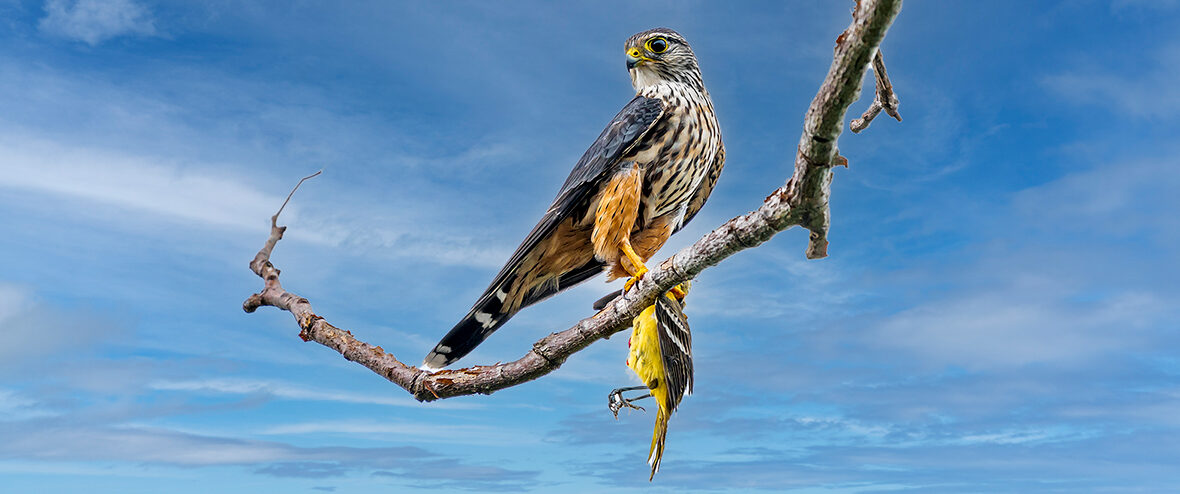
The merlin, aka pigeon hawk, has a near global distribution. In fact, the only 2 continents they can’t be found on are Australia and Antarctica. These diminutive raptors are skilled hunters and fliers that prey on other birds. Due to their extensive locations and vast numbers, they face many threats such as habitat loss and destruction at the hands of farming, ranching, the logging industry, and renewable energy; utility lines, that can cause electrocution; hunting; trapping; recreational activities that interfere with their nesting sites; invasive species, and with them disease; and pollution. The IUCN lists these small birds of prey as Least Concern.
First the Stats…
Scientific name: Falco columbarius
Weight: Up to 8.5 ounces
Length: Up to 11.8 inches
Wingspan: Up to 23 inches
Lifespan: Up to 11+ years
Now on to the Facts!
1.) There were an estimated 3,200,000 wild individuals as of 2021, and their numbers are listed as stable.
2.) They prey on birds as small as sparrows to as large as quails.
3.) Merlins have been utilized in falconry for centuries.
4.) The genus name which is Latin, falco, hails from falx, falcis, or a sickle, referring to their talons. The species name columbarius is also Latin and means “of doves” from “columba”, “dove”.
5.) These birds were first described and illustrated by the English naturalist Mark Catesby, as the pigeon hawk, in 1729 – 1732.
But wait, there’s more on the merlin!
6.) Later, in 1758, Carl Linnaeus included these critters in the 10th edition of his Systema Naturae and introduced the current binomial name Falco columbarius.
7.) The common name “merlin” hails from Old French esmerillon via Anglo-Norman “merilun” or “meriliun”.
Did you know…?
They typically hunt on the wing (in mid flight), flying low and fast; sometimes just 3.3 feet above the ground.
8.) Arguably, the New World and Old World populations have been suggested as separate species. Seeing as their gene flow was severed at least 1,000,000+ years ago. There are numerous subspecies though.
9.) They prefer open countrysides, like birch or willow scrubs, taiga forests, shrublands, parks, grasslands like steppes, prairies, and/or moorlands.
10.) A majority of populations are migratory; wintering in warmer climates.
But wait, there’s still more on the merlin!
11.) While hunting, it is not uncommon for 1 bird to flush out its prey right into the clutches of this predator’s mate.
12.) They are such successful hunters that nearly every other attack ends in a kill, and subsequent meal.
Did you know…?
These raptors have been recorded trying to “catch” moving vehicles such as cars and even trains.
13.) Merlins are seasonally monogamous. However, extra-pair copulations have been recorded.
14.) Females lay up to 6 eggs that hatch in up to 32 days. However, 3 – 4 eggs are more common.
15.) Based on available food, 2/3rd of the hatched young will fledge. In leaner times only 1 of 3 will fledge.
But wait, there’s a little more on the merlin!
16.) In medieval Europe, merlins were quite popular in falconry. In fact, the Book of St. Albans listed it as “the falcon for a lady”, where it was stated that it was for classic “ringing” (circling rapidly upward) chases of the English skylark.
17.) These birds are predominantly diurnal (active during the day). However, they will sometimes exhibit crepuscular (active at dawn and dusk) habits, in order to prey on bats.
18.) Red-tailed hawks, great horned owls, and other larger raptors prey on merlins.
19.) Merlins can fly at speeds of up to 30 mph.
Now a Short Merlin Video!
Be sure to share & comment below! Also, check out the Critter Science YouTube channel. Videos added regularly!
Want to suggest a critter for me to write about? Let me know here.
Some source material acquired from: Wikipedia & IUCN
Photo credit: iNaturalist



